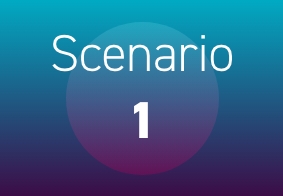
Over the past 24 months, we've seen an increased rate of progress, and significant advances, in the airline retailing journey. Over 80 percent of airlines are investing in offer innovation, NDC is gaining traction, and AI/ML is transforming what is possible in revenue management and analytics.
But one fundamental question remains unanswered: how will it all scale?
Modern airline retailing demands new infrastructure
Present-day pricing and offer infrastructure are an industry cornerstone, trusted by airlines and distribution partners worldwide for half a century. The system uses a well-established orchestration of fares, rules, schedules, availability, and heavy process computation to deliver accurate pricing and millisecond response times. Unfortunately, the entire process was designed for pre-filed prices and won't efficiently scale to support the new world of dynamic, real-time offers.
To successfully scale modern airline retailing, a new offer creation and distribution architecture is required that will:
- Enable real-time, accurate shopping, pricing, and delivery of dynamic airline offers
- Support various pricing models among airlines
- Co-exist with existing processes for years, allowing for a non-disruptive transition
In 2022, ATPCO pledged to build the framework needed for 80 percent of all sold offers to be dynamically created by 2026. This is a watershed moment—and a massive opportunity—to "build it right the first time."
We have spent decades optimizing traditional distribution, including adapting legacy systems and processes. Let's learn from the past and proactively design a new, future-proof architecture that supports dynamic offers at scale and is cost-effective to support over time.
Exploring scenarios for offers @ scale
The ATPCO architecture team has conducted a series of workshops to explore options for dynamic offers at scale. Nothing was off the table! We considered everything from simple options reflecting a modest incremental change to radical solutions that, while more extensive in scope, offer more significant future-proof potential.
Three of the scenarios were Two Worlds (Optimized NDC), Offer Repository, and Integrated Airline Offer Creation Proxies.
Below are highlights of each, and as you'll see, they led us to a fourth idea.

Two Worlds
(Optimized NDC)
- What: Today’s reality for airlines that have NDC (APIs, offers) in parallel with traditional processes
- Pros: Uses existing capabilities, including the ability to shift between paths
- Cons: Complex and challenging performance and connectivity as airlines and partners filter, merge, and present results across streams
- Summary: Current reality, opportunities for improvement, likely will not scale to full industry volume on its own

Offer repository
- What: Intelligent offer caching under full airline control
- Pros: Provides for instant search and supports NDC direct sell/upsell
- Cons: Requires data lake and cache maintenance methods, concerns with accuracy (discrepancies between displayed versus bookable)
- Summary: Partial solution (doesn’t work for real-time pricing)

Integrated airline offer creation proxies
- What: Indirect channels integrate distributed “airline offer creation proxies” for dynamic offer calculation
- Pros: Local proxies provide fast response time
- Cons: Uncertainties about preservation of proprietary airline algorithms as well as process to maintain/update distributed proxies
- Summary: Many challenges as proposed, but a variety of technologies like blockchain, co-location of cloud computing, or other approaches could address some of these challenges
Industry feedback: What do the ATPCO design teams think?
The objective of this research phase was to start a dialogue within ATPCO and with industry stakeholders. For the latter, we engaged with ATPCO's Dynamic Offer Design team, composed of experts and business users from airlines and channels, to hear feedback on the three scenarios.
While the scope of discussion was broad, the direction ATPCO received from the Design teams on the three scenarios was clear:
Make Two Worlds (Optimized NDC) the priority, but don't stop there!
- Because Two Worlds (Scenario 1) is the present-day reality for many airlines and channels, there was naturally a high degree of interest and priority placed on improving it, particularly in the areas of the airline profile, NDC optimization, and the ATPCO Product Catalogue in development. ATPCO is actively working on these items.
- The design teams encouraged ATPCO to continue exploring Scenario 2, "Offer Repository," even though it is not a complete solution for dynamic offers at scale. Despite its limitations, cache will always exist in some form (including "in the wild") and should be addressed by industry processes and use cases accompanying future infrastructure design.
- Scenario 3 (Integrated Airline Offer Creation Proxies) sparked much discussion. The possibility for airlines to have a fast and efficient way to provide access to their proprietary dynamic offers is highly appealing. However, questions on how the proxies would be maintained and integrated into the indirect channel—while remaining proprietary—sent the ATPCO team back to the drawing board. As it turns out, that drawing board exercise proved fruitful and led to exploring alternate technologies for this scenario and a white paper about how blockchain technology might be game-changing when it comes to scaling airline retailing.
Other technologies: Blockchain for dynamic offers @ scale
ATPCO has published a white paper, Retailing at Scale: Achieving scalable airline dynamic offers using blockchain, in which authors Boyan Hristov and Darie Dreptate introduce the Next Generation Distribution Network (NGDN) concept as one technology that could solve scaling retailing.
The NGDN is a proposed new, industry-wide computation platform that uses a distributed blockchain network to augment traditional airline pricing. The NGDN applies airline-defined dynamic pricing logic that will be distributed and controlled by the airline via a blockchain that can be applied to base fares generated by existing shopping engines. The result is that adjusted prices are able to be generated in real time to all blockchain participants, which in practical terms, equate to distribution partners (such as airlines, channels, tech providers, GDSs, travel sellers). And the best part? It is entirely secure, with unlimited scalability!
Airlines using the NGDN could achieve many benefits of the previously discussed Scenario 3 (Integrated Airline Offer Creation Proxies), such as fast, accurate price calculations under the airline's control. However, thanks to the advantages afforded by blockchain technology, the NGDN eliminates concerns expressed about Scenario 3 regarding how to update pricing logic across geographies or preserve proprietary airline information. That's because each node on the NGDN blockchain contains the logic required to execute price calculations locally, in real-time, without cache or network delays.
Other benefits include speedier execution of airline retailing strategies, higher offer persistence, reduced "data bloat," lower network traffic, and reduced look-to-book.
What do you think?
If you want to learn more, check out the white paper and share your feedback.
Also, if you are an airline, tech provider, or channel, I encourage you to join an ATPCO design team, where you can have a tangible impact on the future of airline retailing. We look forward to hearing from you.


